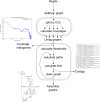Haploflow: strain-resolved de novo assembly of viral genomes
- PMID: 34281604
- PMCID: PMC8287296
- DOI: 10.1186/s13059-021-02426-8
Haploflow: strain-resolved de novo assembly of viral genomes
Conflict of interest statement
The authors declare that they have no competing interests.
Figures




Update of
-
Haploflow: Strain-resolved de novo assembly of viral genomes.bioRxiv [Preprint]. 2021 Jan 26:2021.01.25.428049. doi: 10.1101/2021.01.25.428049. bioRxiv. 2021. Update in: Genome Biol. 2021 Jul 19;22(1):212. doi: 10.1186/s13059-021-02426-8. PMID: 33532769 Free PMC article. Updated. Preprint.
Similar articles
-
Strainline: full-length de novo viral haplotype reconstruction from noisy long reads.Genome Biol. 2022 Jan 20;23(1):29. doi: 10.1186/s13059-021-02587-6. Genome Biol. 2022. PMID: 35057847 Free PMC article.
-
SWAMPy: simulating SARS-CoV-2 wastewater amplicon metagenomes.Bioinformatics. 2024 Sep 2;40(9):btae532. doi: 10.1093/bioinformatics/btae532. Bioinformatics. 2024. PMID: 39226177 Free PMC article.
-
Benchmarking and Assessment of Eight De Novo Genome Assemblers on Viral Next-Generation Sequencing Data, Including the SARS-CoV-2.OMICS. 2022 Jul;26(7):372-381. doi: 10.1089/omi.2022.0042. Epub 2022 Jun 28. OMICS. 2022. PMID: 35759429
-
Haploflow: Strain-resolved de novo assembly of viral genomes.bioRxiv [Preprint]. 2021 Jan 26:2021.01.25.428049. doi: 10.1101/2021.01.25.428049. bioRxiv. 2021. Update in: Genome Biol. 2021 Jul 19;22(1):212. doi: 10.1186/s13059-021-02426-8. PMID: 33532769 Free PMC article. Updated. Preprint.
-
ContigExtender: a new approach to improving de novo sequence assembly for viral metagenomics data.BMC Bioinformatics. 2021 Mar 12;22(1):119. doi: 10.1186/s12859-021-04038-2. BMC Bioinformatics. 2021. PMID: 33706720 Free PMC article.
Cited by
-
COVID Variants, Villain and Victory: A Bioinformatics Perspective.Microorganisms. 2023 Aug 9;11(8):2039. doi: 10.3390/microorganisms11082039. Microorganisms. 2023. PMID: 37630599 Free PMC article.
-
In silico genomic surveillance by CoVerage predicts and characterizes SARS-CoV-2 variants of interest.Nat Commun. 2025 Jul 8;16(1):6281. doi: 10.1038/s41467-025-60231-4. Nat Commun. 2025. PMID: 40628697 Free PMC article.
-
Molecular Epidemiology of HIV-1 in Ghana: Subtype Distribution, Drug Resistance and Coreceptor Usage.Viruses. 2022 Dec 31;15(1):128. doi: 10.3390/v15010128. Viruses. 2022. PMID: 36680168 Free PMC article.
-
Detection and prevalence of SARS-CoV-2 co-infections during the Omicron variant circulation in France.Nat Commun. 2022 Oct 23;13(1):6316. doi: 10.1038/s41467-022-33910-9. Nat Commun. 2022. PMID: 36274062 Free PMC article.
-
Evaluation of shotgun metagenomics as a diagnostic tool for infectious gastroenteritis.PLoS One. 2025 Sep 2;20(9):e0331288. doi: 10.1371/journal.pone.0331288. eCollection 2025. PLoS One. 2025. PMID: 40892803 Free PMC article.
References
Publication types
MeSH terms
Substances
LinkOut - more resources
Full Text Sources

